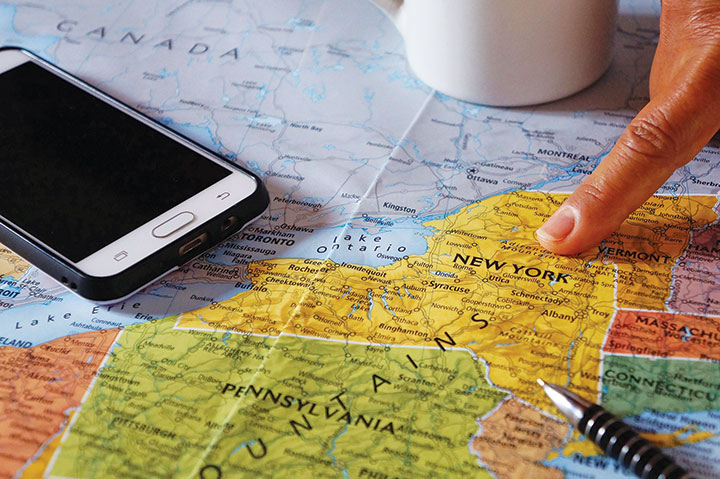The future must ensure physical and mental health safety for all nurses.
Travel nurses and staff nurses can agree that we’ve all had to learn how to care for COVID-19 patients. As Maggie Hansen, chief nursing officer at Memorial Healthcare System in Hollywood, Florida, described it, “Learning how to care for COVID-19 patients has been stressful for every healthcare provider because there’s no clear roadmap for care.”
The pandemic has helped the world recognize the tremendous resilience and adaptability of nurses. Travel nurse veteran and author of the book Travel Nurses Bible, David Morrison, RN, said that his best pandemic experience as a travel nurse has been “the coming together of nurses.” (See Morrison’s article on travel nursing.)
As a traveler (the insider’s term for travel nurses who work short gigs at hospitals around the country), Morrison has seen firsthand how nurses “rose to what might seem an impossible task” during the pandemic. However, for both travelers and staff nurses, experiences from inside the profession have included more than unity in the name of COVID.
The nursing shortage isn’t new
Nursing shortages and the use of travelers to fill those shortages aren’t new to nursing. The issues contributing to shortages—burnout, limited time off, long shifts without breaks, and little administrative attention to retention—existed pre-pandemic.
According to April Hansen, MSN, RN, group president of workforce solutions at Aya Healthcare, in California, “the demand for travel nurses is at an all-time high across the country and is driven by a variety of factors.” Not only has the pandemic stressed the nursing workforce, she said, but also “an increase in permanent hospital vacancies nationwide from burnout and higher census.”
According to the American Nurses Association, more than 500,000 RNs will retire in 2022, leaving more jobs than nurses to fill them. Experts project that 1.1 million new nurses are needed to fill the upcoming vacancies. In a recent American Organization for Nursing Leadership survey, 90% of nurse leaders anticipate that nurse staffing shortages will persist long after a drop in patients with COVID-19.
The pandemic has taken a toll on nurses who care for affected patients. The results of a research study conducted by Aya Healthcare in May and June of 2021 confirmed that the physical and emotional traumas of COVID-19 drove nurses away from core staffing positions or, for some, out of the profession entirely, leaving rifts in an already expanding nursing shortage.
Maggie Hansen reported that Memorial Healthcare System, which had been an employer of choice and ranked among the “Best Places to Work in Healthcare” for 12 of the past 13 years, experienced a 20% nursing turnover rate in the fiscal year ending April 30, 2021, up from 13% before the pandemic. “The pandemic definitely impacted our nursing workforce as well as our overall employee base,” she said.
COVID-induced strains have challenged healthcare’s ability to maintain a stable and efficient nursing workforce. Also, staff nurses pursuing travel nursing presents challenges for the solidarity of the profession.
‘I should get paid a premium’
As COVID-19 pushed more patients into hospital beds, it simultaneously pushed core staff nurses further into long shifts, minimal respite, and painful burnout. Nurses already traveling picked up the pace to help, while staff nurses looking to save their mental health and careers turned to traveling.
Rose O. Sherman, EdD, RN, NEA-BC, FAAN, a nationally recognized leadership development expert, said “Every health system I’ve worked with is experiencing losses of staff to travel positions. Percentages range from a low of 5% to a high of 30%, and this trend has intensified over the past 6 months.” (Read Sherman’s article on nurse recruitment.)
Nurses who are leaving staff positions tell administrators, “If I’m going to work this hard and take care of these complex patients, I should get paid a premium,” Sherman said.
In early fall 2021, staffing agencies such as Nomad Health were offering travel nurse positions weekly salaries ranging from $5,004 to $8,528. At the same time, Aya Healthcare reported a 20% increase (from August 2021 to October 2021) in open travel RN positions. According to April Hansen, the states with the highest demand for travel nurses in late 2021 were California, Texas, and Florida. Specialty, location, and demand have the most impact on traveler compensation.
In early October 2021, Aya Healthcare listed 59,156 travel nurse assignments. The positions in highest demand are “ICU, medical-surgical, telemetry/step down, and ER,” explained April Hansen. “We’re seeing strong demand for surgical services such as operating room nurses and labor and delivery nurses.”
Until COVID-19 stabilizes in the United States, the high demand for travel nurses will likely continue.
‘Nurses are in the driver’s seat’
Nurses find travel positions appealing for several reasons. Many travelers experience better work–life balance, frequently receive higher wages compared to staff nurses, and have the opportunity to travel to new places. According to Sherman, “Nursing leaders tell me that nurses choose to travel for the following reasons: to control their work and scheduling, to try out different geographic areas, and to pay down debt, especially student loan debt.”
Sherman has seen some healthcare systems offer staff nurses “battle pay” or retention bonuses. However, she said, “We have never had so much of the nursing workforce on contingent contracts.”
With more travelers than ever before and increasing numbers of open nursing positions, administrators’ staffing issues present more challenges. Sherman said, “At this point, nurse leaders are using every available resource to staff units and still are finding it extremely challenging. Most leaders would hire more travel or agency nurses to fill in the gaps if they could. The reality is that staffing agencies can’t fill most requests made, and travel nurses have the option to make decisions about which contracts to accept.”
Maggie Hansen, who has worked with many travelers, said that although learning how to care for patients with COVID-19 has been stressful for everyone at Memorial, “a much larger percentage of the nursing workforce was contract labor that had to hit the ground running with an expedited orientation. Travel nurses typically work 12-week contracts, so the investment in teaching ‘the Memorial way’ had to be re-designed to accommodate the turnover associated with travelers,” she said. Regardless, Maggie Hansen remains grateful for the many travelers who already had experience with COVID-19 surges because it aided their onboarding process.
“Because the supply and demand [for travel nurses] is at a huge imbalance, hospitals are having to compete for the limited talent available, and that is driving up pay. Travel nurses are in the driver’s seat,” April Hansen said.
Traveler challenges, staff nurse morale
Being a traveler isn’t always colossal paydays and remote waterfalls. Pandemic or no pandemic, Morrison explained, “The single biggest challenge is the new nursing staff you encounter on each assignment. You’ll be proving yourself over and over and having to make new friends in units that may already be very tight or even cliquey.”
“Working in a new environment; learning new processes, technologies, hospital layouts; and meeting new people are inherently stressful and have been amplified during a crisis like COVID-19,” said Morrison, who noted that issues like personality conflicts or less-than-inviting unit staff are among the top stressors for travelers because “everyone is being pushed to their max. Team nursing is mandatory, and if you can’t find a way to integrate into the team, you’ll have a very hard travel assignment.”
During the pandemic, travelers have encountered dangerous staffing ratios and decreased time with patients. Morrison encourages travelers to be alert to these challenges. “Travelers should protect their licenses. It will be hard to defend a critical mistake if a nurse takes an assignment while knowing that it’s unsafe or way beyond a normal nurse–patient ratio,” he said.
As travelers work to fit in, their presence impacts current staff who are left behind and “work side-by-side with travelers who often make three to six times what they do,” Sherman said.
Andrea Davies, MSN, APRN, FNP-C, of Methodist Hospitals in Indiana works with more travelers than ever before since COVID-19 and feels it has decreased staff nurse morale. “For nurses who are already established as employees, many feel they should be offered incentive pay to bridge the gaps in staffing shortages before travel nurses are brought in.”
According to Davies, “If there is a day of low census, the staff nurse will be cancelled, and the travel nurse is guaranteed to work.” Davies explained that staff nurses “miss out on a day’s work” because hospitals must prioritize the travel nurses’ shifts to honor travel contracts. (See Advice for traveling and staff nurses.)
Advice for traveling and staff nurses
Heed this advice to ensure cohesive teamwork and quality patient care.
Advice for travelers
- Be a patient advocate. Patients remain the priority for all nurses and working with your colleagues as a team ensures thorough patient support.
- Don’t take it personally. Be willing to prove yourself with each new assignment. Some units may be harder to crack than others, but you’ve got this.
- Speak up. Don’t be afraid to question assignments that fall outside of your scope of practice or threaten your license. This includes inadequate nurse–patient ratios or providing care for which you have no training or experience.
- Keep in touch. You may not always want to be a traveler. It’s a good idea to maintain positive relationships you’ve made with nursing managers or administrators in your hometown.
- It’s temporary. The current assignment might be challenging, but your assignment is short term.
- Seek out other travelers. With so many travelers these days, you’re probably not the only one. Ask around on your unit or ask your recruiter about other travelers in your area.
Advice for staff nurses
- Welcome travelers. Embracing help during this pandemic is crucial for everyone. Travelers bring experiences, skillsets, and levels of adaptability that have the potential to make your job easier.
- Spread optimism. Working with travelers doesn’t have to be filled with anxiety and stress. Travelers are colleagues who realize that each unit and hospital is different. They expect to be a useful part of the team while overcoming bumps along the way. You should, too.
- Communicate. To help travelers quickly acclimate to your organization, communicate. Encourage asking for and seeking help to prevent or resolve problems. Provide clarity and direction with graciousness.
- Be inclusive. Including travelers in staff huddles, asking for their input, and inviting them to holiday staff parties will create a supportive atmosphere.
- Be a patient advocate. Patients remain the priority for all nurses.
The future of travel nursing
Travel nursing’s original intent was to fill workforce gaps and shortages until a hospital could hire more nurses. However, as a result of COVID-19, travel nursing has almost become a specialty with its own career path. Said April Hansen, “Travel nurses now make up almost 2% of the nursing workforce.”
The pandemic required staffing agencies to provide high numbers of travel nurses to various areas around the country quickly. Aya Healthcare developed a response to the growing number of nurses considering traveling as a permanent career. “We’ve created the Aya Scholars program,” said April Hansen. “It’s the industry’s first clinical ladder and professional recognition model for travel nurses to ensure their continued career growth.”
With more nurses discovering the benefits of traveling, many wonder what the future of this career path holds. Sherman has worked with organizations around the country. She predicts “there is likely to always be a need for travel nurses, and they will be used to supplement core staffing, especially in geographic areas with seasonal populations.”
However, the unprecedented mass exodus of nurses resulting from the pandemic has left enormous issues for hospitals. The most pressing are nursing shortages and inadequate nurse–patient ratios, which will remain as long as the pandemic continues. “The burden of COVID-19 care will continue to stress our hospitals for quite some time,” Maggie Hansen said.
Using travelers to help fill staffing gaps has been reasonable, but the current cost isn’t a long-term solution. “I know that some leaders are angry about the price gouging they’ve seen with travel contracts,” Sherman said. “As the need for travel nurses decreases, we’ll probably see tougher negotiations on these contracts. The money is likely to be far less in the future for the nurses themselves, and a significant percentage of those who are currently on travel assignments won’t travel in the future.”
The future of hiring and retention
Indirectly, COVID-19 has bolstered the travel nursing industry, and in turn, travel nurses have modified the nursing profession. Sherman said, “When nurses travel and gain control over their work, it will be hard to shut that door.”
As travelers take control of their careers by picking and choosing assignments and locations, staff nurses are taking note. “Nurse leaders tell me that a change they’ve seen in their staff since COVID is an intense desire for work–life accommodation,” Sherman said. “Most health systems have pretty rigid ‘work rules’ that require 12-hour tours and don’t accommodate part-time work.”
According to Sherman, “If health systems expect to recruit and retain younger generations of nurses, administrators will need to be more flexible in the future. Historically, some nurses have liked overtime, but this has changed with younger nurses.” The implication is that younger generations value time and work–life balance over compensation.
In addition, travel agencies have made it much easier for nurses to jump through hiring hoops. “Most staffing and travel agencies do the same background checks and licensure verification that health systems do themselves,” Sherman explained. “However, these agencies have more user-friendly technology for nurse applicants. In my discussions with nurse leaders, most understand that human resources practices need to change. Nurses won’t wait weeks to learn if they’re selected for a position. I think we’ll see changes in this area post-COVID.”
Sherman expects the competition for travel nurses to decrease over time. “The nurses themselves will make less money in the future in travel assignments,” she said. “I think we’ll see student loan repayment programs
in many health systems to help nurses pay down their debt.”
But right now, during the pandemic, as hospital administrators inch their way toward viable methods of recruiting and retaining staff nurses, hiring travel nurses remains the costly norm for filling vacant positions. As Maggie Hansen noted, “Paying travel nursing rates to fill the vacancies caused by the COVID-19 crisis isn’t sustainable. So, strategies for returning to a more stable, engaged, and cost-effective nursing workforce have to be a priority.”
The pandemic emphasized the wage gap between nurses working full time and travelers. To avoid losing trained staff or using costly third-party staffing agencies, many organizations began addressing staffing issues with internal travel programs. This solution allowed hospitals and health systems to pay nurses lucrative travel wages, enjoy flexible schedules, and remain local.
Protecting nurses
For both staff nurse and traveler, this pandemic has highlighted the nurse’s sense of duty and dedication to patient care while at the same time expanding concerns about personal safety and occupational risks. We’ve learned that opportunity and compensation aren’t enough to maintain a stable nursing workforce. COVID-19 may have changed how staff and travel nurses work in the U.S. healthcare system, but we must continue to ensure the physical and mental health of every single nurse.
Julie Nyhus is a nurse journalist and nurse practitioner at Community Healthcare System in Michigan City, Indiana.
References:
American Nurses Association. Nurses in the workforce.
American Organization for Nursing Leadership. Nurse leaders’ top challenges, emotional health, and areas of needed support, July 2020 to August 2021.
Aya Healthcare. The pandemic has dramatically impacted nurses.


















